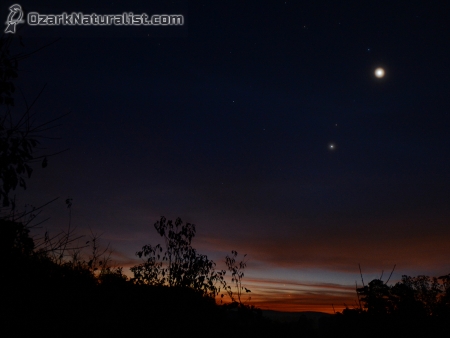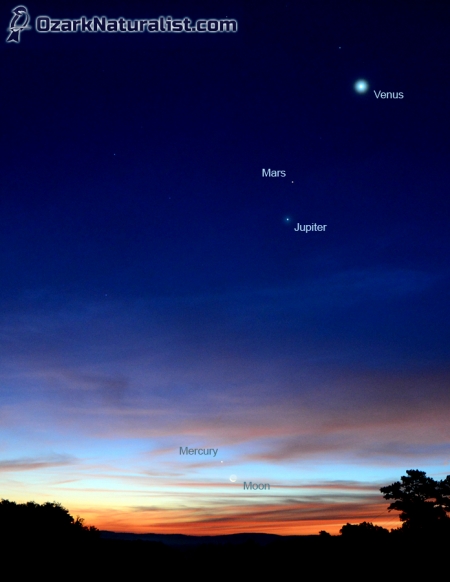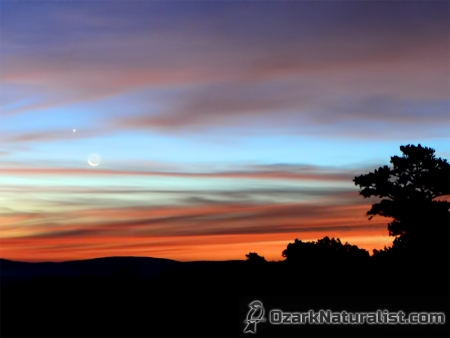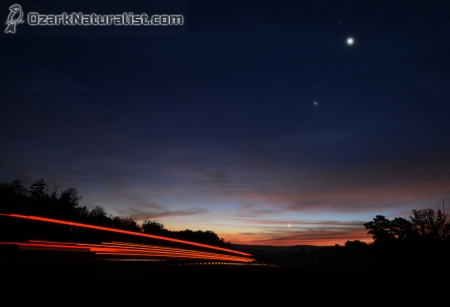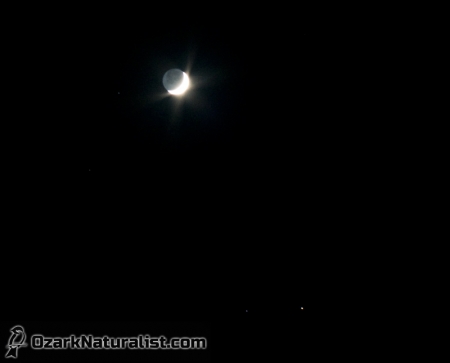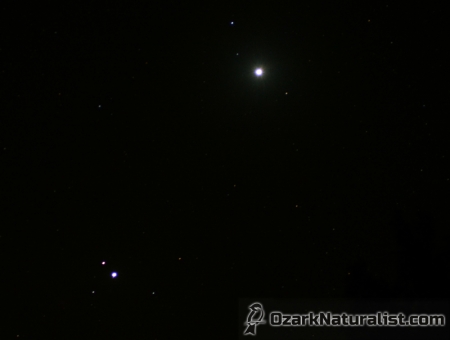Following up on my last astronomy-related post, Bailey did indeed drag me out of bed early last Sunday morning (10/11). By 6:00 a.m., I was set up next to the east bound lane of Highway 60, about 2 miles east of Fremont. This is where the highway crosses the top of a tall ridge, providing a great view of the eastern sky. There is also a Forest Service road turning to the south, the first hundred feet or so paved, so I didn’t have to park on the shoulder of the main road (very unsafe) and I still had a solid surface to set up the tripod.
This was my first shot of the day, a five second exposure at f/2.8 and ISO 800. I wasn’t happy about those clouds at first, but they ultimately weren’t really a problem and they made the photo’s much more interesting and colorful. That super bright flare in the upper right is Venus, while Jupiter is the next brightest, down and to the left. Faint Mars is just right of straight up of Jupiter.
The one I was really looking for, though, was Mercury. It was supposed to be very near the horizon, in conjunction with a thin sliver of Moon. The clouds are in the way in this first photo, obscuring the Moon almost completely, but you can just make out Mercury, slightly right of center and a short distance above the horizon.
The clouds thinned out a bit in this photo, allowing both Mercury and the Moon to show through.
Here’s a deeper crop of the same image with a closer look at the Moon-Mercury conjunction. The Moon was only 2% illuminated at the time, but that illuminated part is still a little over-exposed in the image. The remaineder of the Moon’s disk was illuminated by earthshine, sunlight reflected from the Earth’s surface, and an effect I usually have trouble capturing in photos. I wasn’t even trying here and manage to catch it anyway. Figures.
There thankfully wasn’t a lot of traffic while I was shooting—Highway 60 isn’t terribly busy at 6:00 a.m. on a Sunday—but there were a few, maybe eight or ten vehicles. I heard this one coming up the hill behind me and waited until it came even with me to trigger the shutter. Kinda looks like the Flash went zooming by at just the right time, doesn’t it? I have another that captures a vehicle coming from the other direction, but at least in this case, headlights aren’t nearly as attractive as tail lights.
Follow-up from this Weekend
I captured another couple of conjunction related images this weekend that I want to show, but I don’t think they merit a separate post so I’m going to stick them here.
The first was from Friday (10/16) evening. Here we have a waxing crescent Moon, over-exposed as always, the unlit part of its disk once again illuminated by earthshine. The Moon is joined by Saturn, the bright, yellowish “star” in the lower, right-central part of the image. The star you can see near Saturn is Beta Scorpii, a multiple star system also known as Acrab, from the word al-`Aqrab, Arabic for scorpion and Graffias, a name of apparently unknown derivation. Thank you, Wikipedia.
The second image was shot just before dawn yesterday, 10/17. Venus, showy as always, grabs your attention first. But look to the lower left corner and you find Mars and Jupiter, less than a half degree apart. Now that is a conjunction. Of course, they only seem to be close together because of where we’re viewing them from. According to WolframAlpha, at the time I took the photo they were actually more than 350 million miles apart. Not that that stops astrologers from placing a lot of importance on this conjunction and conjunctions in general.
I’m not going any further down that particular rabbit hole, so that’s it for today. I have at least two more astronomy posts in the pipeline and then we’ll probably move on to something else.
